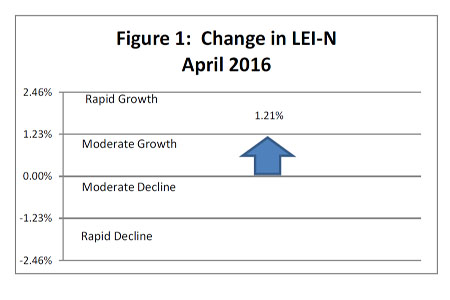The Nebraska economy should grow rapidly during the second half of 2016, according to the latest leading economic indicator report from the University of Nebraska-Lincoln.
The indicator, a composite of economic factors that predict growth six months into the future, increased by 1.21 percent in April.
 May 2016 Leading Economic Indicator Nebraska
May 2016 Leading Economic Indicator Nebraska
“The rapid increase in the value of the leading indicator signals strong economic growth in Nebraska during the second half of 2016” said economist Eric Thompson, director of the Bureau of Business Research at the University of Nebraska-Lincoln.
“Improving trade competitiveness, when combined with a strengthening labor market and business environment, provide a basis for strong, broad-based economic growth in Nebraska,” said economist Eric Thompson, director of the Bureau of Business Research at the University of Nebraska-Lincoln.
April’s increase follows a sharp increase in March, Thompson said. The two months combined signal strong economic growth in the state during the second half of the year.
Three components of the leading indicator improved during April. Respondents to the April
Survey of Nebraska Business predicted strong growth in both sales and employment at their businesses over the next six months. There was also a decline in initial claims for unemployment insurance, a positive sign for the labor market, as well as another decline in the value of the U.S. dollar. The declining dollar will benefit Nebraska’s export-oriented businesses in manufacturing and agriculture.
On the negative side, there was a modest decline in building permits for single-family homes and in manufacturing hours in Nebraska during April.
The leading economic indicator report is produced monthly by faculty and students in the Economics Department and the Bureau of Business Research in UNL’s College of Business Administration.
Published: May 20, 2016